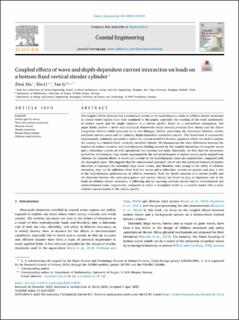| dc.contributor.author | Xin, Zirui | |
| dc.contributor.author | Li, Xin | |
| dc.contributor.author | Li, Yan | |
| dc.date.accessioned | 2024-03-25T08:30:21Z | |
| dc.date.available | 2024-03-25T08:30:21Z | |
| dc.date.created | 2023-05-15T13:02:35Z | |
| dc.date.issued | 2023 | |
| dc.identifier.issn | 0378-3839 | |
| dc.identifier.uri | https://hdl.handle.net/11250/3123977 | |
| dc.description.abstract | The coupled effects of waves and a subsurface current on the hydrodynamic loads on offshore slender structures in coastal water regions have been examined in this paper, especially the coupling of the weak nonlinearity of surface waves and the depth variation of a current profile. Based on a narrowband assumption, this paper firstly derives a novel semi-analytical framework which extends potential flow theory and the Direct Integration Method (DIM) proposed by Li and Ellingsen (2019), permitting the interaction between weakly nonlinear surface waves and an arbitrary depth-dependent subsurface current. This framework is numerically implemented, validated, and used to lead to the current-modified Morison equations which are used to analyze the loading on a bottom-fixed, vertically installed cylinder. We demonstrate the clear differences between the features of surface elevation and hydrodynamics loading exerted by the coupled interaction of irregular waves and a subsurface current in both operational and extreme sea states. Especially, we find that the occurrence probability of extremely large events represented by the statistical features of surface waves can be insignificant whereas the coupled effects of waves and current on the hydrodynamic loads are considerable, compared with the decoupled cases. This suggests that the conventional approach, which uses the statistical features of surface elevation to represent the extremely large wave events, and therefore risks posing to the safety of offshore structures, may not be sufficient when both the waves and a subsurface current are present and play a role in the hydrodynamic performances of offshore structures. Both the depth variation of a current profile and the direction between the wave propagation and current velocity are found to play an important role in the loads on offshore slender structures. A following and an opposing uniform current lead to overestimated and underestimated loads, respectively, compared to either a decoupled model or a coupled model with a more realistic representation of the current profile. | en_US |
| dc.language.iso | eng | en_US |
| dc.publisher | Elsevier | en_US |
| dc.rights | Navngivelse 4.0 Internasjonal | * |
| dc.rights.uri | http://creativecommons.org/licenses/by/4.0/deed.no | * |
| dc.title | Coupled effects of wave and depth-dependent current interaction on loads on a bottom-fixed vertical slender cylinder | en_US |
| dc.type | Journal article | en_US |
| dc.type | Peer reviewed | en_US |
| dc.description.version | publishedVersion | en_US |
| dc.rights.holder | Copyright 2023 The Author(s) | en_US |
| dc.source.articlenumber | 104304 | en_US |
| cristin.ispublished | true | |
| cristin.fulltext | original | |
| cristin.qualitycode | 2 | |
| dc.identifier.doi | 10.1016/j.coastaleng.2023.104304 | |
| dc.identifier.cristin | 2147568 | |
| dc.source.journal | Coastal Engineering | en_US |
| dc.relation.project | Norges forskningsråd: 287389 | en_US |
| dc.identifier.citation | Coastal Engineering. 2023, 183, 104304. | en_US |
| dc.source.volume | 183 | en_US |

